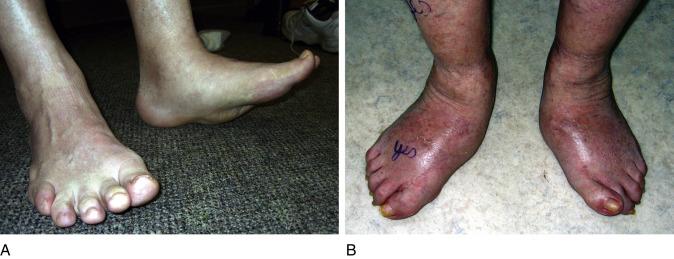Physical Address
304 North Cardinal St.
Dorchester Center, MA 02124
Charcot described neuroarthropathic arthropathy typically due to syphilis in the late 1880s.
Although most current cases are due to diabetes, 20–30% of cases occur as a result of other neuropathic conditions: alcohol neuropathy, rheumatologic neuropathy, hereditary neuropathy, steroid-induced neuropathy, spinal injury, spinal tumor, spina bifida (syringomyelia), and many coexisting conditions.
Refers to aggressive destruction of the bones and joints as a result of repetitive microtrauma, recognized or unrecognized acute trauma, arthritis, or avascular necrosis. Often there is an inciting event that goes unrecognized, and the destructive process is magnified by repetitive trauma.
Charcot neuroarthropathy:
May present in an acute or chronic fashion
Can involve any portion of the foot and ankle
Can lead to severe deformities with risk for ulcers and infection and possibly osteomyelitis
Neuropathic patients have either acute trauma (fracture, ligament injury, tendon disruption, or dislocation) or repetitive microtrauma or spontaneous avascular necrosis of either the navicular or the talus. Arthritis may also be a precursor by triggering inflammation or destruction that may also lead to Charcot collapse.
The situation that begins as above is compounded by the patient’s activity coupled with lack of awareness that the foot is swelling and deforming.
Often comorbidities such as obesity, renal disease, vitamin D deficiency, and vascular disease will aggravate the situation by increasing the mechanical and biologic stresses to these vulnerable bones and joints.
Ulceration and infection increase the inflammatory environment and further lead to destructive arthropathy.
The synovium plays a critical role in producing cytokines that mediate the bone and joint destruction.
Without mechanical relief for the foot and ankle, the bones and joints progressively become destroyed.
The foot becomes deformed and unstable. The midfoot can develop a rocker-bottom deformity. There may be abduction or adduction of the forefoot or midfoot. The hindfoot may assume a varus or valgus deformity.
Bony prominences occur at the apex of the deformities, and over fragmented, dislocated, or displaced bones.
The hindfoot and midfoot joints collapse, leading to equinus of the talus in the ankle joint and relative dorsiflexion of the metatarsals or cuneiforms on the more proximal midtarsus or transverse tarsus.
Progressive Achilles tendon contracture occurs.
The foot contacts the shoe or ground with vulnerable bony prominences.
These pressure areas become ulcerated.
The ulcers lead to superficial and deep infection.
Osteomyelitis and septic joints may develop.
Uncontrolled infection leads to limb loss.
Recurrent ulcer
Deep infection
Instability
Severe malalignment
Unbraceable deformity
Inability to wear shoes
Acute
A swollen, warm, erythematous foot and ankle are seen.
Gross foot deformities include rocker-bottom foot, severe abduction and pronation, or less often adduction and supination.
Deformity can be flexible and unstable.
Equinus contracture may occur.
Bony prominences occur at the apex of deformities.
Ulcers manifest over the prominences.
Chronic
Deformities include rocker-bottom foot ( Fig. 27.1A ) and severe abduction, adduction, supination, and/or pronation ( Fig. 27.1B ).

Deformities are not reducible.
If destruction occurs through fracture, the deformity can be stiff and stable.
If the deformity is through a dislocation, the deformity can be unstable.
Additional findings include:
Mild swelling
Mild warmth
Mild to no erythema
The foot tends to be thicker due to soft-tissue and bony changes.
General
Evaluate the patient for systemic infection.
Peripheral vascular status should be assessed; pulses should also be checked.
Cardiac/renal/pulmonary function may be impaired.
Local
Charcot type: location, that is, which joints are involved
Charcot stage: clinical severity of deformity
Charcot phase (Eichenholtz): acute, subacute, chronic
Neuropathy: decrease in two-point discrimination; decrease in sensitivity to light touch, vibration, and temperature
Ischemia
Dorsalis pedis and posterior tibialis pulses may be decreased; perform a side-to-side comparison
Additional signs and symptoms include cool foot, painful ulcer, gray base, eschars, odor, weak or absent pulses
Depth of ulcer and infection
Rule out
Deep venous thrombosis
Osteomyelitis (probe the ulcer to see whether it contacts the bone)
Acute Charcot Neuroarthropathy
Subluxation, dislocation, and/or fracture of any part of the midfoot and hindfoot may not be distinguishable from normal acute trauma
Chronic Charcot Neuroarthropathy
Deformity: resulting from fracture and/or dislocation
Hypertrophic arthritis
Avascular changes to bone with sclerosis and fragmentation, deformity (loss of normal shape)
Consolidation of bone fragmentation
Zones of radiodensity with bone remodeling
Joint subluxation/dislocation
Bone fractures with hypertrophic malunions and nonunions
Become a Clinical Tree membership for Full access and enjoy Unlimited articles
If you are a member. Log in here